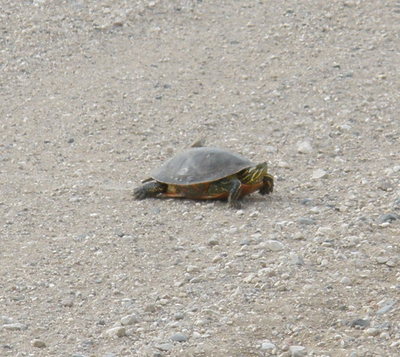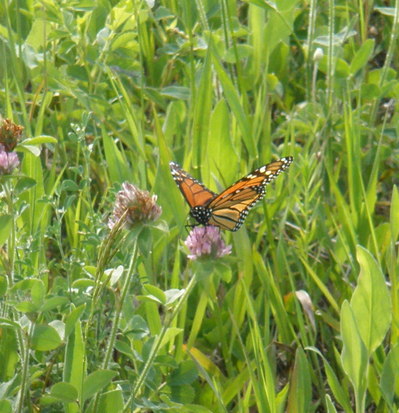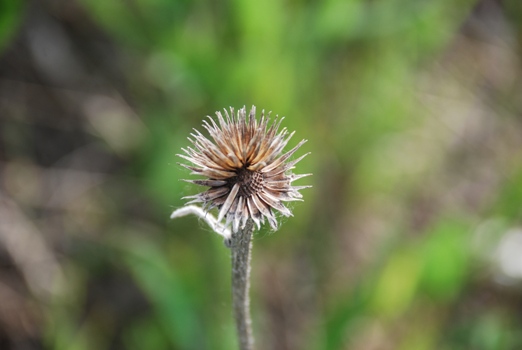|
|
Greetings from the green prairie! After a few days in the field, I feel I have a good handle on the projects done in the past and the current research. My name is Greg Diersen and this is my first year with Team Echinacea. I teach Biology (happy pollinator week) at Great Plains Lutheran High School in Watertown, South Dakota. That location in NE South Dakota is about a 2-hr drive from the Kensington/Hoffman area. They both have a “prairie pothole” landscape and have many of the same flora/fauna. My initial projects for this summer are to become “prairie literate” – able to identify the majority of plants and many insects in addition to the larger organisms with which I am already familiar. As I learn the “tallgrass” plants and insects – I will be comparing and contrasting the “mixed” prairie types of Eastern South Dakota.
So, here is my revised project plan. I spent about 2 hours with Stuart today going over the procedure, and I think the randomization aspect and sampling aspect has been redesigned a bit better.
DanRathProposal.doc
Please let me know what you think. A bit more revision is to come, but this gives the basic idea.
Today was a beautiful day on the prairie. Got to try out my new bike this morning, and rode to the farm in a half hour. That last hill is a killer though. This afternoon, I rode back along Unity Drive, and noticed some Brome grass that had its anthers sticking out. Mistook it for a new type of plant at first. Nice warm weather with a nice breeze, so wonderful bike riding on those gravel back roads. Pictures will come eventually!


Those are just 2 of the many cool encounters I had yesterday on my bike ride past Hegg Lake and through Runestone Park. I also saw: pelicans, an American egret, a hare, tons of red-winged blackbirds and many other birds I can’t yet identify, a wild turkey, a skink, and lots of interesting pollinators. I also saw some flowering Echinacea along the side of the road…I think Stuart probably knows about them (?) but I didn’t see any tags and there ones that had flowered last year as well.
I thought I’d also flog the decisions we’d made last week about chores. The tasks are:
>sweep daily: G3–Mimi, the front porch–Allegra, and inside–Gretel
>clean the table tops and put away chairs daily–Amanda
>organize the bins and flags in G3 daily–Daniel
>shake out the rugs once a week–Amanda
>clean the bathroom once a week–?
-Mimi
So, here is my proposal for looking at aphid proportion and density in the different prairie remnants this summer, as well as the presence of spittlebugs. Please criticize and let me know what you think.
DanRathProposal.doc
For the preliminary observations done to get an idea of the number of plants with aphids, I spent yesterday morning scanning the common garden for Aphids. I looked at rows 2, 3, 14, and 40, and wen through them up to the 20 meter mark. I found 3 plants with aphids and 5 with spittlebugs. For the younger plants, I scanned rows 51, 54, 55, and 56, and found 5 plants with spittlebugs and 3 with aphids. Given that I missed some, I would say that of the 270 plants looked at, roughly 2% had aphids.
Yesterday afternoon was also spent pressing plants, where I learned some of the finer points, such as ensuring that the flowers and leaves were well separated, how to fold some plants over, and to ensure that some leaves were turned over so that both sides of a leaf were captured. It is also very important to label clearly, and BEFORE you put the plant in the paper.
The little miss Runestone parade is today, and it is very likely that pictures of this event will be referenced or posted in later posts. (Depending on the varying levels of cuteness).
Also, here is the really cool paper on Spittlebugs, aphids and ants that I found: http://psyche.entclub.org/pdf/97/97-043.pdf
Daniel R.
Calling all Veggie Lovers! Anyone interested in a CSA basket? I’ll call this farm tomorrow to see if they will give us a partial summer share for the weeks we are here. They deliver to Alexandria on Thursdays.
Ploughshare Farm
(218) 267-5117
http://www.ploughsharefarm.com
Also, Alexandria Farmers’ Market
Tues & Sat 9 – noon & Thursday 3 – 6 pm.
(320) 763-6893
http://www.mfma.org
Located in Big Ole Central Park at Broadway and 2nd Ave., in Alexandria. Offering a full line of locally raised fruits and vegetables including: apples, beans, beets, blueberries, broccoli, cabbage, carrots, cucumbers, herbs, lettuce, onions, peas, peppers, potatoes, pumpkins, raspberries, squash, strawberries, sweet corn, tomatoes, bedding plants, flowers, elk, lamb, beef and chickens. New location, South of Agnes Lake on the Central Lakes Trail, 1/2 block north of the Chamber Office/Runestone Museum
And, Berry Ridge Farm
Call for hours, May-Nov. (320) 763-6893
1301 Firemans Lodge Road SW. Located 2 miles west of Alexandria on the east side of Lake Latoka. Blueberries, strawberries, raspberries, tomatoes, beans, peas, cucumbers, pumpkins, squash and more.
Let the jam making begin!
I found these farms and more at http://www3.mda.state.mn.us/mngrown
Here’s my proposal for my project. Read it. Savor it. Constructively criticize it.
jenkins echinacea proposal.doc
It’s still very helter-skelter at this point and in need of much fine-tuning, so any suggestions are greatly appreciated. Thanks!
Also, I’ll re-attach the docx files from my last post in doc format.
Echinacea Pollinators nesting2.doc
Protocol for Taking Pictures of Insect Specimens.doc
On a side note, yesterday was a really exciting day because I found my first seedling, we got two bikes at a garage sale for $25 each, and there were the Runestone Days fireworks in the evening. The party lasted long into the night in K-town, and I think I remember falling asleep to the sweet sounds of AC/DC You shook me all night long coming from the street dance. These folks know how to party. I’m looking forward to the kiddie parade tomorrow! Although Amanda and I were saddened to hear it wouldn’t be a kitty parade.
Hello again, field log readers–
I know it’s been a trying twenty hours of waiting, but I now have more details regarding my independent project!
GallinatProposal.doc
Just by clicking on my proposal (above) you will get an idea of the specific questions I’d like to answer, how I plan to go about answering those questions and how my study fits into this summer’s bigger picture work on competition for pollination. Take it from me, it’s a riveting read!
I would greatly appreciate any questions or comments about this proposal– whether you are part of the Project or just an Echinacea enthusiast in K-town for Runestone Days, feel free to write in the comments. Thanks!
My name is Allegra Halverson and I am from New Hampshire. I am an undergraduate student in Botanical Science at McGill University in Montreal, and a recent addition to Team Echinacea. Lots of things happened this week, so here are a few highlights:
We moved into the old town hall and I’ve been loving the bike ride to the farm in the mornings so everyone with access to a bike should bring it!
I saw a garter snake, two frogs, two deer, ground squirrels, a wild turkey and lots of birds.
Gretel and I selfed Megan J’s prairie turnip plants at the landfill site on Wednesday. We also helped Andrea put out flags and fungal traps in the CG for her mycorrhizae project.
I started my plant collection at the landfill and common garden with 15 plants so far. I have to make a plant collection for a class next winter and will also make one for the Echinacea project at the same time to help future newbies with plant identification.
During this first week we received a lot of background information on the project and began the planning stages of our own projects related to the larger questions about Echinacea in the fragmented prairie habitat. Several projects surrounding the question of competition for pollinators were chosen along with pollen identification projects and one project about the aphids. My project will focus on how inter-specific pollen landing on Echinacea flowers effects style persistence. pollen competition proposal.doc
We developed a new key for the labeling seedling search maps:
-each plant in the circle has a dot with line drawn to the center and the distance (cm) to the focal plant written on the line
s with a circle around it: a seedling
B with a circle around it: a basal plant, not flowering
* with a circle around it: a flowering plant, should have a metal tag like this 7819.2 (.2 is the number of flowering heads)
N with a circle around it: a nail with a metal tag on it
any plot with a plant found in it, other than the focal plant, had a map made for it.
any plot with a seedling found in it was photographed and a pencil marker with a letter (for basal or seedlings) or number (for numbered plants) was placed 2 cm west of all plants
a toothpick was placed 5 cm from the seedling towards the focal plant
am i missing anything?
I should introduce myself to the new Team – I’m Ruth Shaw. I’ve collaborated with Stuart and the Team on this project since 2000. I’m a professor at the University of Minnesota in the Department of Ecology, Evolution and Behavior. Broadly speaking, my research addresses questions about ongoing evolution in plant populations, and I have found this project on the evolutionary consequences of fragmentation of populations of Echinacea endlessly stimulating!
I’m just back from the joint meeting of the Society for the Study of Evolution, The American Society of Naturalists, and the Society of Systematic Biology, where I gave a brief talk about some of our results based on 7-years of data on “Inb1” an experiment to compare the effects of inbreeding and of crossing between remnants. This experiment has been growing in the common garden since 2000, and we have now documented that the degree of inbreeding depression is exceptional, far exceeding that found in other studies. Intriguingly, we have also found that both inbreds and progeny of between remnant crosses harbor more of the specialist aphid than plants derived by random mating within remnants.
A special highlight of the meeting is that our paper about estimating fitness, with examples (available via the main echinacea website), received the President’s Award, chosen by the current President of ASN as outstanding paper of 2008 in the journal, The American Naturalist. Quite an honor!
I was out in Douglas County in late May for the early monitoring of seedling recruitment in the remnants, and I’m glad to hear that process is moving forward well! I’m looking forward to getting back out there and working with you all soon!

Hello, Echinacea lovers–
I’m Amanda Gallinat, a recent grad of Carleton College and brand new field assistant to the Echinacea project. After a quick transition from Northfield to K-Town (Kensington, to those of you who don’t live here) I am finally settling into the daily routine of seedling searches, lunch, and more seedling searches.
On Monday we paid a visit to Staffenson Prairie and memorized the scientific and common name of each plant species we saw. Just kidding! We did get an idea of the general composition of the prairie, as broken down into four groups: C3 grasses, C4 grasses, legumes and forbs. I managed to leave with the ability to identify a large handful of species, and I’ll be sure to update the Flog with my progress in learning all the rest!
Over the past few days, we’ve focused a lot of our energy on seedling searches, and it seems as though we newbies are really getting the hang of the procedure. So far we haven’t searched any sites brimming with seedlings, but we have all seen some fine examples and each group has had the life-affirming experience of finding and identifying a seedling, if only once.
We’ve also spent some quality time discussing independent project ideas. My primary area of interest is plant-pollinator interactions, and I am excited to spend this summer investigating how the diversity of pollen carried by pollinators differs between remnant sizes (design details will be posted soon, so check in!). This should fit well with three other independent projects relating to competition for pollination, and might give us insight into why an increased frequency of pollinator visitation in isolated populations of Echinacea does not correlate with an increased seed set. Think we can solve the mystery? Stay tuned for updates…
If you have any questions or words of encouragement, feel free to leave them in the comments!
|
|



